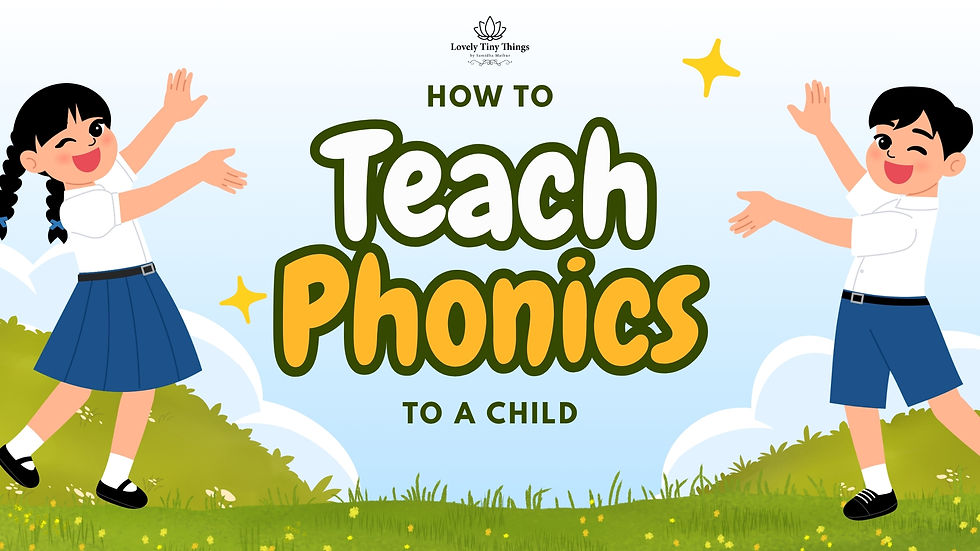5 Easy Ways Teach Phonics to a Child
- Aug 11
- 5 min read

Teaching a child to spell English words can often feel like a challenging journey. English spelling is full of quirks—silent letters, unusual pronunciations, and exceptions to rules—that can confuse even the most eager young learner. I vividly remember when I started helping my daughter learn to read and spell. She would sometimes get frustrated when a word didn’t sound like it looked or when the spelling seemed inconsistent. What helped us most was focusing on the fundamentals — particularly understanding how to teach phonics to a child. This approach slowly transformed our sessions from struggles into moments of excitement and progress.
If you’re wondering how to teach a child to spell English words effectively and want them to read fluently with confidence, you’re in the right place. This blog shares five easy, practical ways to nurture your child’s reading and spelling skills, anchored around the key principle of phonics.
How to Teach Phonics to a Child: The Foundation of Spelling and Reading

Phonics is often described as the building block of learning to read and spell. It’s the method of teaching children the relationship between letters and the sounds they represent. When a child understands this connection, they gain the ability to decode new words independently—a critical step toward fluent reading.
When I began teaching my daughter, we started with simple phonics sounds rather than jumping straight to spelling full words. For example, before attempting to spell the word “cat,” we worked on the individual sounds: /c/, /a/, /t/. This helped her understand that letters are symbols representing sounds, which she could then blend to form words.
Tips on How to Teach Phonics to a Child Effectively
Use playful activities: Incorporate phonics songs, rhymes, and games that focus on letter sounds.
Flashcards with images: Use cards that show a letter alongside a picture representing the sound (e.g., ‘A’ with an apple).
Sound matching games: Ask your child to identify the beginning or ending sounds in simple words.
Teaching phonics to a child is not just about memorising sounds; it’s about developing the skill to listen carefully and link those sounds to letters. This foundational understanding simplifies spelling and reading, making the learning process less intimidating for children.
Break Words into Manageable Chunks: A Step Toward Fluent Spelling

English words can often look overwhelming, especially for young learners. Long words with multiple syllables can cause confusion and anxiety. One of the strategies I found most effective with my daughter was breaking words into smaller, manageable chunks or syllables. This helped her focus on one part of the word at a time rather than trying to tackle the entire word in one go.
For instance, the word “elephant” can be broken down into three chunks: el-e-phant. Saying each part slowly and clearly allows children to process and spell more accurately.
How to Practice Chunking with Your Child
Encourage your child to clap or tap their fingers as they say each syllable aloud.
Have them write each chunk separately before putting the whole word together.
Use common words from daily conversations, like “butterfly” (but-ter-fly) or “computer” (com-pu-ter), to practice chunking.
This approach not only makes spelling easier but also improves pronunciation and reading fluency. It’s especially helpful for children who feel overwhelmed by longer words.
Engage Multiple Senses: Making Spelling a Hands-On Experience

One key lesson I learned while helping my daughter was that children remember things better when they engage in more than one sense during learning. The more senses involved, the stronger the memory connection. That’s why multisensory learning techniques are so powerful when teaching spelling.
Practical Multisensory Techniques for Teaching Spelling
Tactile learning: Let your child write words in sand, salt trays, or with finger paints. The physical act of forming letters reinforces memory.
Manipulative letters: Use magnetic letters or letter blocks that your child can move around to build words.
Auditory reinforcement: Encourage your child to say each letter and the whole word out loud as they spell.
These activities transform spelling from a passive activity into an interactive, hands-on experience. When children feel involved physically and vocally, they are more likely to retain what they learn and enjoy the process.
Practice Sight Words Daily to Build Reading Fluency
Another critical piece of the puzzle when teaching children to read and spell English words is mastering sight words. Sight words are frequently used words that often don’t follow standard phonics rules and thus need to be recognised on sight. Words like “the,” “was,” “said,” and “come” fall into this category.
I noticed a remarkable change in my daughter's reading fluency once she began to recognise sight words quickly. Instead of hesitating on every tricky word, she could read entire sentences smoothly, which boosted her confidence tremendously.
How to Incorporate Sight Word Practice
Create a set of flashcards with common sight words and review them regularly.
Encourage your child to spot sight words in storybooks or daily reading materials.
Turn sight word learning into a game, such as bingo or matching pairs.
Mastering sight words frees your child’s mental energy to focus on decoding new words using phonics, leading to overall improved fluency and comprehension.
Read Together Every Day: The Power of Shared Stories

Finally, one of the most effective ways to support your child’s spelling and reading journey is by making daily reading a joyful, shared experience. When I started reading storybooks aloud with my niece every evening, it became a special time for both of us—a time to explore new worlds and build skills.
Tips for Making Reading Time Effective and Fun
Let your child take turns reading aloud with you to build confidence.
Pause to discuss and spell out new or difficult words.
Ask questions about the story to improve comprehension and engagement.
Reading together does more than improve spelling and vocabulary; it builds a lasting love for books and learning. Even a brief 10- to 15-minute daily session can make a significant difference.
Final Thoughts: Patience, Encouragement, and Consistency Matter Most
Learning to spell English words fluently doesn’t happen overnight. It requires patience, positive reinforcement, and consistent practice. Celebrate every small success, and remind your child that mistakes are just stepping stones on the path to mastery.
By focusing on how to teach phonics to a child through fun, multisensory, and chunked learning, practising sight words daily, and sharing reading moments, you’re giving your child the tools to become a confident reader and speller.
If you’re looking for more personalised strategies or a supportive community to guide your child’s learning journey, Lovely Tiny Things offers workshops and resources designed to nurture every child’s unique potential.
















Comments